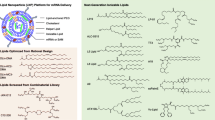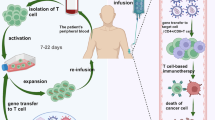Abstract
Purpose. The purpose of this study was to design a well-characterized liposomal carrier system for multivalent antigen presentation in order to activate T cells.
Methods. MHC class II molecules were loaded with peptide and subsequently reconstituted into liposomes. A FACS assay was developed to monitor peptide loading and MHC class II incorporation in the liposomes. For in vitro testing of the resulting MHC class II/peptide liposomes, a T cell hybridoma assay was employed.
Results. The FACS assay provided a qualitative means to visualize the amount of incorporated MHC class II and peptide molecules that were oriented in the appropriate way for antigen presentation to the T cells. Interestingly, when MHC class II molecules were loaded with the appropriate peptide prior to liposome incorporation, such liposomes were fully capable of inducing IL-2 production of a T cell hybridoma.
Conclusions. This is the first article showing that MHC class II/peptide liposomes can serve as 'artificial antigen presenting cells' for activation of a CD4+ T cell hybridoma. As compared to soluble MHC class II/ peptide complexes, the multivalency of liposomal complexes may be an important advantage when studying possible applications in immunotherapy.
Similar content being viewed by others
REFERENCES
J. D. Ashwell and R. H. Schwartz. T-cell recognition of antigen and the Ia molecule as a ternary complex, Nature 320:176–179 (1986).
C. H. June, J. A. Bluestone, L. M. Nadler, and C. B. Thompson. The B7 and CD28 receptor families. Immunol. Today 15:321–331 (1994).
M. K. Jenkins and R. H. Schwartz. Antigen presentation by chemically modified splenocytes induces antigen-specific T cell unresponsiveness in vitro and in vivo. J. Exp. Med. 165:302–319 (1987).
M. L. Dustin, J. M. Miller, S. Ranganath, D. A. A. Vignali, N. J. Viner, C. A. Nelson, and E. R. Unanue. TCR-mediated adhesion of T cell hybridomas to planar bilayers containing purified MHC II/peptide complexes and receptor shedding during detachment. J. Immunol. 157:2014–2021 (1996).
J. D. Altman, P. A. H. Moss, P. J. R. Goulder, D. H. Barouch, M. G. McHeyzer-Williams, J. I. Bell, A. J. McMichael, and M. M. Davis. Phenotypic analysis of antigen-specific T lymphocytes, Science 274:94–96 (1996).
K. Matsui, J. J. Boniface, P. Steffner, P. A. Reay, and M. M. Davis. Kinetics of T-cell receptor binding to peptide/I-Ek complexes: correlation of the dissociation rate with T-cell responsiveness. Proc. Natl. Acad. Sci. USA 91:12862–12866 (1994).
D. S. Lyons, S. A. Lieberman, J. Hampl, J. J. Boniface, Y. Chien, L. J. Berg, and M. M. Davis. A TCR binds to antagonist ligands with lower affinities and faster dissociation rates than to agonists. Immunity 5:53–61 (1996).
M. W. Nicolle, B. Nag, S. D. Sharma, N. Willcox, A. Vincent, D. J. Ferguson, and J. Newsom-Davis. Specific tolerance to an acetylcholine receptor epitope induced in vitro in myasthenia gravis CD4+ lymphocytes by soluble major histocompatibility complex class II-peptide complexes. J. Clin. Invest. 93:1361–1369 (1994).
S. Arimilli, J. B. Mumm, and B. Nag. Antigen-specific apoptosis in immortalized T cells by soluble MHC class II-peptide complexes. Immunol. Cell Biol. 74:96–104 (1996).
J.-P. Abastado, Y.-C. Lone, A. Casrouge, G. Boulot, and P. Kourilsky. Dimerization of soluble major histocompatibility complex-peptide complexes is sufficient for activation of T cell hybridoma and induction of unresponsiveness. J. Exp. Med. 182:439–447 (1995).
Z. Reich, J. J. Boniface, D. S. Lyons, N. Borochov, E. J. Wachtel, and M. M. Davis. Ligand-specific oligomerization of T-cell receptor molecules. Nature 387:617–620 (1997).
S. Valitutti and A. Lanzavecchia. Serial triggering of TCRs: a basis for the sensitivity and specificity of antigen recognition. Immunol. Today 18:299–304 (1997).
A. S. Shaw and M. L. Dustin. Making the T cell receptor go the distance: a topological view of T cell activation. Immunity 6:361–369 (1997).
G. F. Kersten, A. M. van de Put, T. Teerlink, E. C. Beuvery, and D. J. Crommelin. Immunogenicity of liposomes and iscoms containing the major outer membrane protein of Neisseria gonorrhoeae: influence of protein content and liposomal bilayer composition. Infect. Immun. 56:1661–1664 (1988).
A. Chakrabarti, J. Matko, N. A. Rahman, B. G. Barisas, and M. Edidin. Self-association of class I major histocompatibility complex molecules in liposome and cell surface membranes. Biochemistry 31:7182–7189 (1992).
T. H. Watts, A. A. Brian, J. W. Kappler, P. Marrack, and H. M. McConnell. Antigen presentation by supported planar membranes containing affinity-purified I-Ad. Proc. Natl. Acad. Sci. USA 81:7564–7568 (1984).
H. Quill and R. H. Schwartz. Stimulation of normal inducer T cell clones with antigen presented by purified Ia molecules in planar lipid membranes: specific induction of a long-lived state of proliferative nonresponsiveness. J. Immunol. 138:3704–3712 (1987).
B. P. Babbitt, G. Matsueda, E. Haber, E. R. Unanue, and P. M. Allen. Antigenic competition at the level of peptide-Ia binding. Proc. Natl. Acad. Sci. USA 83:4509–4513 (1986).
C. M. Coeshott, R. W. Chesnut, R. T. Kubo, S. F. Grammer, D. M. Jenis, and H. M. Grey. Ia-specific mixed leukocyte reactive T cell hybridomas:analysis of their specificity by using purified class II MHC molecules in a synthetic membrane system. J. Immunol. 136:2832–2838 (1986).
I. Joosten, M. H. Wauben, M. C. Holewijn, K. Reske, L. O. Pedersen, C. F. Roosenboom, E. J. Hensen, W. van Eden, and S. Buus. Direct binding of autoimmune disease related T cell epitopes to purified Lewis rat MHC class II molecules. Int. Immunol. 6:751–759 (1994).
J. M. Steward and J. D. Young. Solid Phase Peptide Synthesis. Pierce Chemical, Rockford, IL (1984).
W. Jiskoot, T. Teerlink, E. C. Beuvery, and D. J. A. Crommelin. Preparation of liposomes via detergent removal from mixed micelles by dilution: the effect of bilayer composition and process parameters on liposome characteristics. Pharm. Weekbl. [Sci] 8:259–265 (1986).
L. S. Minamide and J. R. Bamburg. A filter paper dye-binding assay for quantitative determination of protein without interference from reducing agents or detergents. Anal. Biochem. 190:66–70 (1990).
A. M. H. Boots, M. J. van Lierop, M. H. M. Wauben, P. J. S. van Kooten, E. J. Hensen, and W. van Eden. CD4 rat x rat and mouse x rat T cell hybridomas produced by fusion of established T cell lines and clones to W/Fu(C58N)D. J. Immunol. Meth. 144:1–10 (1991).
K. Dornmair, B. Rothenhausler, and H. M. McConnell. Structural intermediates in the reactions of antigenic peptides with MHC molecules. Cold Spring Harbor Symp. Quant. Biol. 54:409–416 (1989).
B. Nag, P. V. Mukku, S. Arimilli, D. Phan, S. V. Deshpande, and J. L. Winkelhake. Antigenic peptide binding to MHC class II molecules at increased peptide concentrations. Mol. Immunol. 31:1161–1168 (1994).
N. K. Childers, S. M. Michalek, J. H. Eldridge, F. R. Denys, A. K. Berry, and J. R. McGhee. Characterization of liposome suspensions by flow cytometry. J. Immunol. Meth. 119:135–143 (1989).
L. S. Taams, A. J. M. L. van Rensen, M. C. M. Poelen, C. A. C. M. van Els, A. C. Besseling, J. P. A. Wagenaar, W. van Eden, and M. H. M. Wauben. Anergic T cells actively suppress T cell responses via the antigen presenting cell. Eur. J. Immunol. 28:2902–2912 (1998).
Author information
Authors and Affiliations
Corresponding author
Rights and permissions
About this article
Cite this article
van Rensen, A.J.M.L., Wauben, M.H.M., Grosfeld-Stulemeyer, M.C. et al. Liposomes with Incorporated MHC Class Il/Peptide Complexes as Antigen Presenting Vesicles for Specific T Cell Activation. Pharm Res 16, 198–204 (1999). https://doi.org/10.1023/A:1018864005620
Issue Date:
DOI: https://doi.org/10.1023/A:1018864005620




